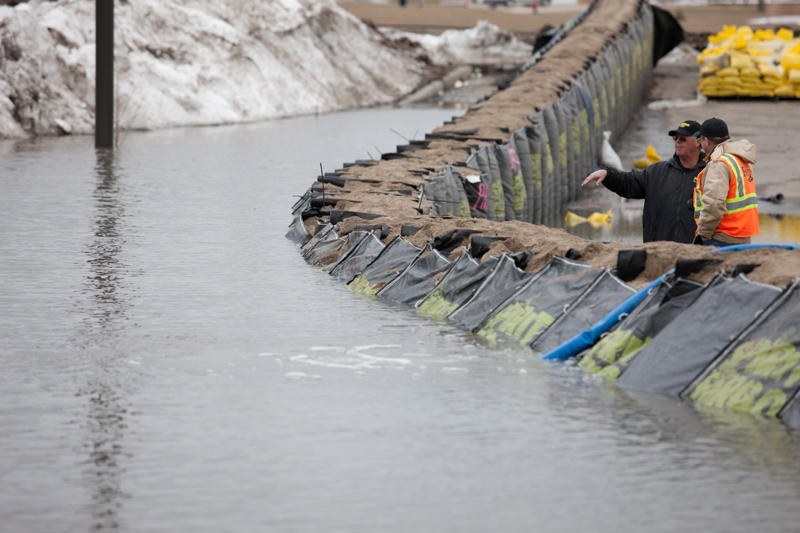What Is the Effect of Flooding on Property Value?
The effect of flooding on property value can be devastating and costly to repair, but you can prevent extensive damage with the help of TrapBag barriers.

Maintaining a high property value is crucial for commercial property owners, as it directly impacts their financial stability and investment returns. However, flooding can significantly diminish property value and pose detrimental consequences for owners. By exploring how flooding affects commercial property values, we can better understand the importance of reliable flood protection and how TrapBag® flood barriers offer an effective solution to safeguard commercial properties.
What Brings Down Property Value?
Flooding can bring down property value due to the following reasons:
- Structural damage: Floodwaters can compromise the integrity of buildings, leading to damage to walls, roofs, and foundations. The force of the water and the prolonged exposure to moisture can weaken structural components, resulting in costly repairs and decreased property value.
- Increased pressure on walls and foundations: The pressure exerted by groundwater during flooding can put excessive strain on walls and foundations, leading to cracks, shifting, or even collapse.
- Mold growth: Flooding creates a damp environment that promotes the growth of mold and mildew. Mold infestation not only damages the property’s aesthetics but also poses health risks to occupants.
- Electrical and mechanical damage: Floodwaters can damage electrical systems, including wiring, outlets, and appliances. It can also affect mechanical systems such as HVAC units and plumbing.
- Contamination and environmental hazards: Floodwaters can carry contaminants, pollutants, and hazardous substances, posing a threat to the environment and surrounding ecosystems. If the property is located near sensitive areas or water sources, the potential environmental impact can significantly decrease its value.
- Insurance costs: Properties in flood-prone areas often require higher insurance premiums or may face challenges in obtaining adequate coverage. The increased insurance costs can make the property less attractive to potential buyers.
It is important for commercial property owners to address these factors and implement reliable flood protection measures to safeguard their investment and maintain a high property value.
How Much Does Flood Damage Cost?
Recent years have witnessed a significant increase in the cost of flood-related property damage. The financial impact can be staggering, with repairs and restoration costs ranging from thousands to millions of dollars depending on the severity of the flooding event. In fact, the average water damage insurance claim for home repairs is $11,605. This underscores the importance of proactive measures to prevent and mitigate flood damage.
Determining Flood Risk of Your Commercial Property
Location, proximity to bodies of water, historical flood data, and vulnerability to heavy rainfall can impact your commercial property’s level of flood risk. Even properties in areas not typically considered high flood risk can experience flooding due to changing weather patterns.
Commercial Flood Damage Due to Climate Change
With climate change exacerbating weather patterns, the occurrence and severity of flooding have increased. As a result, commercial property owners must be proactive in implementing flood protection measures to safeguard their investments and mitigate potential losses. Reliable flood protection solutions are essential to counter the escalating flood risks associated with climate change.
Protect Your Investment with TrapBag Flood Barriers
TrapBag flood barriers are designed to provide reliable and effective flood protection for commercial properties. These specially engineered barriers are incredibly durable, ensuring long-term performance and resistance to floodwaters. They are leak resistant and can be quickly deployed when needed, offering versatile solutions to adapt to various flood scenarios. Whether a commercial property requires temporary protection during a flooding event or a permanent flood barrier for ongoing protection, TrapBags can be tailored to meet specific needs.
Types of Commercial Property Flood Barriers
- Dams: TrapBags can be deployed to create temporary or permanent dams to block and redirect floodwaters. Dams are effective in controlling the flow of water and preventing it from infiltrating the property.
- Dikes: TrapBags can be stacked to form temporary or permanent dikes along the perimeter of the property. Dikes act as barriers to prevent floodwaters from encroaching onto the property, providing a reliable defense against flooding.
- Levees: TrapBags can be arranged to construct levees, which are raised embankments designed to contain and redirect floodwaters. Levees offer a higher level of protection by confining water within designated channels or areas and keeping the property safe from flooding.
- Floodwalls: TrapBags can be configured to build floodwalls, which are vertical barriers that provide protection against rising water levels. Floodwalls are commonly used in areas prone to coastal flooding or near rivers to prevent water intrusion into the property.
The choice between temporary and permanent flood barriers depends on several factors, including the property’s flood risk profile and the owner’s specific requirements:
- Temporary barriers: Temporary flood barriers are ideal for immediate flood response and can be quickly deployed when a flood event is anticipated. These barriers are versatile, portable, and can be easily adjusted or relocated as needed.
- Permanent barriers: In cases where the property faces a high risk of recurring floods, permanent flood barriers may be necessary. These barriers provide continuous protection against potential flood events. They are designed to withstand long-term exposure to floodwaters and offer ongoing defense for the property.
Choosing the appropriate type of flood barrier, whether temporary or permanent, allows commercial property owners to effectively mitigate the risks associated with flooding and protect their assets from potential damage.
Benefits of TrapBag Barriers
- Incredible durability: TrapBags are built to withstand the forces of floodwaters and are made from strong, high-quality materials that can resist punctures and tears, ensuring long-lasting performance.
- Leak resistant design: TrapBags are designed to create a watertight barrier, minimizing the risk of water seepage or leakage. Their interlocking system and specialized construction prevent water from breaching the barrier.
- Quick deployment: TrapBags can be rapidly deployed, allowing for swift response in flood situations. Their lightweight and flexible nature make them easy to transport and install, enabling efficient flood protection when time is of the essence.
- Versatility: TrapBags are adaptable to various flood scenarios and can be customized to suit different property layouts and flood risk levels. They can be easily adjusted, stacked, or combined to create the desired flood barrier configuration.
- Permanent flood barriers: In addition to their use as temporary flood barriers, TrapBags can serve as permanent flood protection measures. When installed properly, they can provide continuous defense against potential flood events, offering long-term security for commercial properties.
By utilizing TrapBag barriers, commercial property owners can benefit from their exceptional durability, reliable leakproof design, ease of deployment, adaptability, and the option for permanent flood protection. These advantages contribute to effective flood mitigation and safeguarding of valuable assets.
Get Reliable Flood Protection for Your Commercial Property
Don’t leave your commercial property vulnerable to the devastating effects of flooding. Contact us today to learn more about TrapBag flood barriers and how they can effectively protect your investment from flood damage. Ensure the longevity and value of your property with reliable flood protection measures.
Meet the author
Get the Dirt Before the Flood Hits
Stay ahead of flooding, erosion, and disaster response challenges. The Dirt, TrapBag’s monthly newsletter, delivers field-tested tips, real-world case studies, and the latest in barrier technology straight to your inbox.

